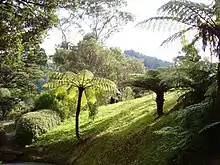| Trachypepla photinella | |
|---|---|
 | |
| Scientific classification | |
| Domain: | Eukaryota |
| Kingdom: | Animalia |
| Phylum: | Arthropoda |
| Class: | Insecta |
| Order: | Lepidoptera |
| Family: | Oecophoridae |
| Genus: | Trachypepla |
| Species: | T. photinella |
| Binomial name | |
| Trachypepla photinella | |
| Synonyms[2] | |
| |
Trachypepla photinella is a moth of the family Oecophoridae first described by Edward Meyrick in 1883.[1] It is endemic to New Zealand and has been collected in Wellington, Wainuiomata, D'Urville Island and Christchurch. The preferred habitat of this species is native forest and adults are on the wing from December until February.
Taxonomy
This species was first described by Edward Meyrick in 1883 using a specimen collected in the Wellington Botanic Garden in January and named Eulechria photinella.[3][2] In 1918 Meyrick placed this species in the genus Trachypepla.[4] This placement was followed by George Hudson when he discussed and illustrated this species in his book The butterflies and moths of New Zealand.[5] The male holotype specimen is held at the Natural History Museum, London.[2]
Description
.jpg.webp)
Meyrick described this species as follows:
♂. 17 mm. Head fuscous-grey mixed with ochreous- whitish, especially on face. Palpi fuscous-grey, base of terminal joint, and extreme apex of second ochreous-whitish. Antennae fuscous- grey. Thorax fuscous-grey, irrorated with whitish. Abdomen light ochreous-grey, anal tuft whitish-ochreous. Anterior and middle legs dark fuscous-grey, with ochreous-whitish rings at middle and apex of tibiae, and apex of tarsal joints ; posterior legs ochreous-whitish, tarsal joints grey towards base. Fore-wings moderately elongate, somewhat dilated, costa moderately strongly arched, apex round-pointed, hindmargin very obliquely rounded ; light fuscous-grey, irregularly irrorated and suffused with whitish, especially in disc and posteriorly ; base of wing very narrowly suffused with dark fuscous ; a very ill-defined small dark fuscous-grey spot on costa at f, and a similar rather larger one on costa slightly beyond middle ; a third on inner margin slightly before middle ; a tolerably well-defined small roundish dark fuscous spot in disc before middle, a second obliquely before it on fold, and a third in disc beyond middle ; a short inwardly oblique cloudy dark fuscous-grey streak from costa at 4⁄5, emitting an irregular outwards-curved line to inner margin before anal angle ; apex dark fuscous-grey ; cilia whitish, at and above apex suffused with grey, on basal half irregularly mixed with dark fuscous-grey. Hindwings grey ; cilia white, with a dark-grey line near base.[3]
Distribution

T. photinella is endemic to New Zealand.[6] As well as the type locality this species has been documented as having been collected in Wainuiomata, at D'Urville Island and in Christchurch.[5][7]
Habitat
The preferred habitat of this species is native forest.[5]
Behaviour
Adults of this species are on the wing from December to February.[8]
References
- 1 2 Gordon, Dennis P., ed. (2010). New Zealand inventory of biodiversity: Kingdom animalia: chaetognatha, ecdysozoa, ichnofossils. Vol. 2. p. 462. ISBN 978-1-877257-93-3. OCLC 973607714. OL 25288394M. Wikidata Q45922947.
- 1 2 3 John Stewart Dugdale (23 September 1988). "Lepidoptera - annotated catalogue, and keys to family-group taxa". Fauna of New Zealand. Department of Scientific and Industrial Research. 14: 107. doi:10.7931/J2/FNZ.14. ISSN 0111-5383. Wikidata Q45083134.
- 1 2 E. Meyrick (1883). "Descriptions of Australian Microlepidoptera. VIII. Oecophoridae". Proceedings of the Linnean Society of New South Wales. 7: 541–542. doi:10.5962/BHL.PART.22763. ISSN 0370-047X. Wikidata Q56012086.
- ↑ Edward Meyrick (15 July 1918). "Descriptions of New Zealand Lepidoptera". Transactions and Proceedings of the New Zealand Institute. 50: 134. ISSN 1176-6158. Wikidata Q113331787.
- 1 2 3 George Vernon Hudson (1928), The butterflies and moths of New Zealand, Illustrator: George Hudson, Wellington: Ferguson and Osborn Limited, p. 283, LCCN 88133764, OCLC 25449322, Wikidata Q58593286
- ↑ "Trachypepla photinella (Meyrick, 1883)". www.nzor.org.nz. Retrieved 2022-05-03.
- ↑ Hooson, Scott (29 January 2015). "Christchurch District Plan. Site of Ecological Significance: Lion Rock" (PDF). districtplan.ccc.govt.nz. Retrieved 29 July 2022.
- ↑ "Trachypepla photinella Meyrick, 1883". www.gbif.org. Retrieved 2022-07-29.